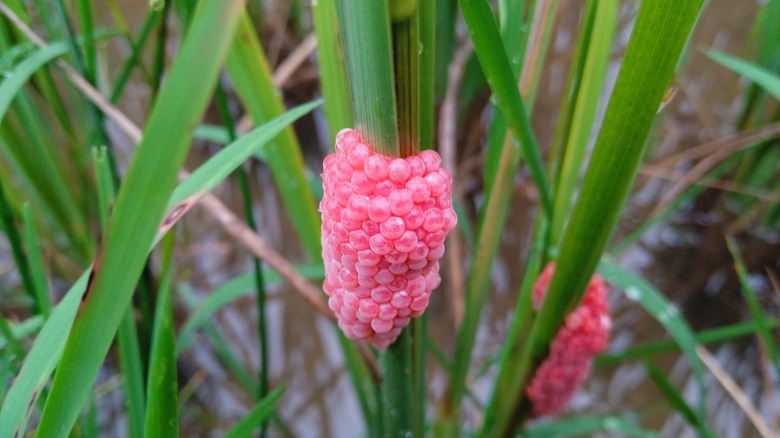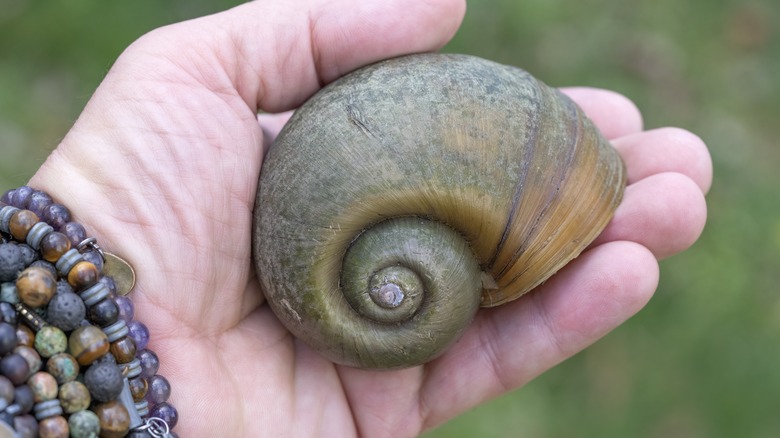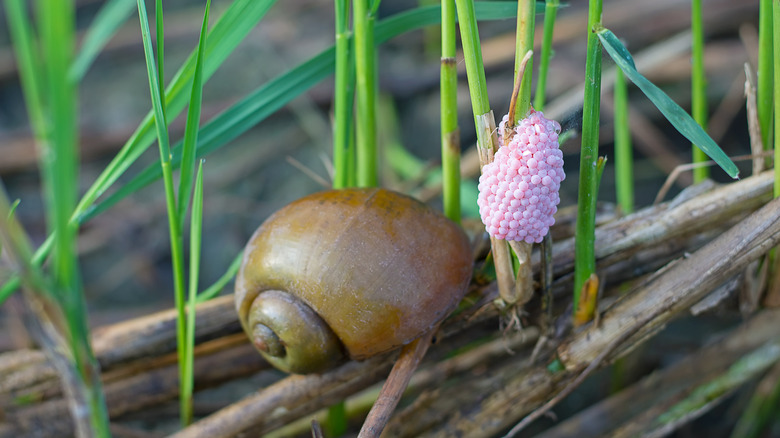What It Means If You Spot Tiny Pink Eggs In Your Garden
Plants help form the natural habitat of thousands of species of animals so you may catch a glimpse of strange things in your garden now and then. You have to keep a watchful eye out, though, to make sure you don't entertain any critters that could pose a threat to the safety of your home or garden. Finding clusters of pink eggs on the foliage or other surfaces in your garden should be a cause for concern. These bright pink eggs belong to the apple snail (Pomacea canaliculata), an invasive species notorious for destroying the balance of the area it finds itself in.
Apple snails are freshwater snails that are considered to be one of the worst garden pests out there. These invasive critters can ravage your garden, devouring your plants and competing for resources with other native wildlife including fish. They are small but mighty, and the same can be said about their bright pink eggs.
Despite being water snails, apple snail eggs are laid in clumps above the waterline which means you would see them in your garden if you have an infestation. The eggs contain a surface neurotoxin that, when handled by people, can irritate your skin and eyes. You definitely don't want your pets or children around the egg clusters, either. Luckily, there are ways to rid your garden of these detrimental pests and their eggs before they establish themselves.
Removal methods for apple snails and eggs
Managing apple snails is tricky. It won't be easy to get rid of them because, being freshwater snails, they are often only found in water bodies and you're unlikely to go looking for them there. Draining the freshwater source in your yard is one option. Apple snails have a few natural predators such as raccoons, the snail kite, and the limpkin, but this won't be helpful unless you have an army of raccoons and birds at your command.
You can pick off the snails you find in your garden and get rid of them, but the most effective way to decrease their population is by targeting the next generation — those pesky pink eggs. You can use two pieces of cardboard to scrape off the eggs from the surface they're on and destroy them by crushing them. If you do manage to find some of the adult snails in the garden, you can pick them up and dispose of them.
Before you go looking for the snails or their eggs, make sure you cover your hands with safety gloves. Apple snails are vectors of the rat lungworm parasite which can cause severe brain infection in humans. While this parasite is typically obtained by eating raw or undercooked snails, it is also believed that you can contact the parasite by handling an infected snail whose mucus contains the parasite's larvae.
Preventive options
The best way to counter unwanted animals in your garden is to deplete their resources and force them to find food, water, and shelter elsewhere. Since apple snails mostly live submerged in freshwater bodies in and around your yard, draining freshwater sources is a great preventive strategy. Once the water is drained, you can pick out the existing snails in the water body. This method is usually carried out by rice farmers in Asia, as well as Louisiana, but if you have a freshwater pond in your garden that attracts apple snails, consider draining it to protect your plants and animals. Apple snails also chow on algae that grow in ponds. Talk to a pond expert to know how best you can clean your garden pond to remove one of the snails' food sources.
Sometimes, draining your pond is understandably out of the question. What you want to avoid is using certain molluscicides, or chemical snail killer, as a prevention method for apple snails in the water. While some are biodegradable, others are known to have detrimental side effects on fish species in the water, especially if they contain metals, such as copper-based molluscicides. The best preventive method will be keeping an eye out for bright pink eggs and getting rid of them before they hatch into mollusks.


